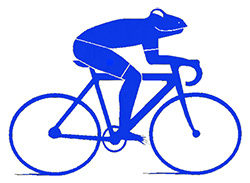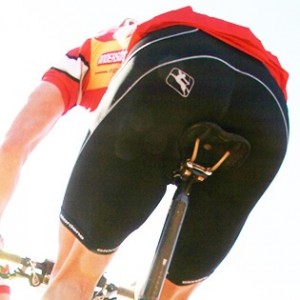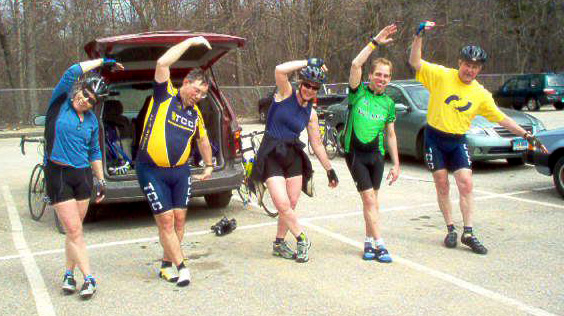A Compendium of Techniques for Posterior Preservation
By John Hankins
The biggest complaint I hear from beginning cyclists, as well as whiny cycling veterans is related in one way or another to discomfort on the bike saddle. When God created Adam and Eve, he wasn’t thinking much about how his gluteal design would work going down the road on a Cannondale. Experimentation and innovation is the key to finding your personal comfort zone in the saddle. In this article, I hope to share some of the insight I’ve gained through numerous episodes of abraded epidermis, be-numbed tender parts, and other maladies in the saddle so that you can learn from my misfortune. As someone that has done just about everything wrong that there is to do on a bike, I consider myself eminently qualified to opine on this topic.
Cycling Shorts and What’s Under Them
Underwear – I don’t want to have to say this twice – DON’T WEAR IT. You just spent $100 on the latest high-tech moisture-wicking, shock absorbing, chafe-resistant, biocidal bike shorts. Why would you want to put a soggy pair of $2.99 cotton Fruit of the Looms under these and undo the advantages of your high-tech investment? Take a close look at the riders in the Tour de France – you won’t see any visible panty lines. I’ve asked the Directors of the Club to be searching for VPLs in our own ranks at the beginning of this year’s group rides. If you’re wearing underwear, we will hunt you down and you will be forced to remove your undergarments in the parking lot.
Most cyclists have discovered that the days of riding in cutoff denim jeans are over and that padded lycra is the way to go. Given this as a starting point, I offer a few comments on cycling shorts. The pad in cycling shorts is typically called the “chamois”, regardless of its composition. Originally constructed from the hide of deceased mountain goats, the material is now typically synthetic; however, we still call it chamois to pay homage to the generations of goats that signed the donor card and then gave their life to this cause. It’s not unusual to hear a cyclist refer to a pair of shorts in mileage terms, such as a “30- mile short” or a “50-mile short”. The 30-mile short is the pair that you wish you had not donned when you are 40 miles into a 100-mile ride. While the bargain basement shorts in the Performance Bicycling mail order catalog might be fine for a short ride, they generally will not be OK if you’re going to be in the saddle for more than a few hours. As a very general rule, more expensive shorts tend to offer more comfort over the long haul and are worth the investment. TCC has had several generations of shorts over the years, some better than others – the biggest hits have been the Sugoi shorts for the men (2006 edition) and the Louis Garneau shorts for the women (2007 edition). In both cases, the key is the quality of the chamois – it’s the reason expensive shorts are expensive, and the reason they are more comfy after you’ve been in the saddle for several hours.
There are a few members of the club (yours truly included) that have been known to wear two pairs of bike shorts to preserve their rumpuses on longer rides, particularly for multi-day events. Although this approach certainly increases the tush protection factor, it also doubles the amount of fabric around the legs and can be constricting. To counter-act this, I typically wear an older pair on the outside that no longer has the elastic properties of its youth.
Saddles
You gotta love those spring-loaded foam-padded wide-load bike seats that grace the displays of many bike shops. Although they look comfy and may feel nice in the shop, these barco-lounger versions of the modern bike saddle are a disaster after a few miles. It seems a little counter-intuitive, but the most comfortable bike seats over the long haul are usually narrow and firm, with only a modest amount of padding. On a 2000-mile bike tour I took with John Jackman and Al Chasse a few years back there was a veteran cyclist riding on a 100-gram saddle that consisted solely of an unpadded molded strip of carbon fiber. He explained that this was the most comfortable saddle he’d ever ridden on. While I don’t think that would do it for most of us, he’d grown accustomed to it and it was working for him.
In general, a good saddle for 20 miles or more is relatively narrow, relatively firm, and shaped in a manner that properly supports your “sit bones”. Those are the bones on either side of your pelvis that support the vast majority of your weight as you head down the road. In between these bones is that particularly sensitive part of the anatomy that none of us relish mashing, regardless of gender. It is for this reason that many modern bike saddles have a cut-out or soft section in the middle . . . gosh, this reminds me of a story . . .
A few years back my bike rides were being hampered by a common type of male nether-region numbness that has been described euphemistically as “sleepy peepie”. To address this condition, I purchased an anatomical saddle from Terry Bicycles with the characteristic central cutout. After viewing this peculiar design, my 10-year old daughter asked me why there was a hole in the middle of the bike seat. With impressive tact and without providing any details, I indicated that this type of saddle was more comfortable for me. She looked back innocently and asked, “Is it a penile issue?” Aghast at her youthful insight, I did not answer her question and sent her off to speak to her mother.
In the end, the answer on saddle selection is one of personal taste. If the saddle you purchased with the bike is working for you, go with it. If not, try something else. There are probably quite a few club members like me that have a box of cast-off saddles in a box in the garage. Ask around and you might score one of these. Several of us have had good luck with both men’s and women’s saddles from Terry Bicycles (www.terrybicycles.com); however, there are probably nearly as many opinions on brands and styles as we have riders.
Creams, Jellies, and Other Mysterious Lubricating Potions
The advent of lycra and well-designed padding in bike shorts has greatly reduced the degree to which riders become chafed in their posterior nether-regions. However, regardless of how good your shorts are there’s a limit to how much rubbing the skin can take before it starts to complain. I’ve experimented with a bunch of different “lubes” where the skin meets the chamois and have had good luck with two.
Chamois Butt’R can be purchased in many bike stores or by mail order. It can be applied to the skin or to the chamois of your shorts, or both, and works well over moderate distances. It has the consistency of face cream and comes in squeeze bottles that are easy to use. I like it because it is water soluble and cleans up easily after the ride. However, it does not have the staying power of some petroleum-based lubes, and may need to be re-applied if you’re on a very long ride. I know some riders who will not do a ride of any length without first applying a thin layer on their skin.
For those of you that want maximum protection over long distances, I’d suggest lanolin based “Bag Balm”. Think of it as Vaseline with attitude. Bag Balm was developed in 1899 in Vermont, and “has been the farmer’s friend, helping keep dairy cows from becoming chapped from the harsh Vermont environment”. In its classic use, this slippery gel is applied directly to the teats of cows to protect them from the elements. While most cyclists I know avoid venturing out in winter with their teats exposed, many have discovered that a pre-ride application beneath the bike shorts can make them much less susceptible to chafing. The only down-side is that it is greasy like Vaseline, and it can leave an interesting signature on your bike seat or any furniture you may happen to sit on during a mid-ride lunch break (might make for an interesting clue in my upcoming cycling-related murder mystery). Bag Balm can be purchased from any of your favorite dairy cow supply houses, including Mackey’s in Willimantic.
A note of caution regarding the application of any of these lubes – you can overdo it. A few years back, a club member, let’s just call him Steve Sokoloski (maybe not his real name), was on a long wet ride suffering from the effects of skin abrasion. To ease his woes, he borrowed a tube of Chamois Butt’R and proceeded to apply approximately half the contents to his area of distress. Shortly thereafter, his cohorts noticed a frothy white cream emanating from the front of his shorts and asked, “is that Chamois Butt’r or are you just happy to see us?”. It was agreed that this was not a distinguished look or one that presented our cycling club in its best light. Mr. Sokoloski (still might not be his real name) was admonished and asked to be more judicious in future applications of this helpful salve.
Other Miscellaneous Tips
If you are new to cycling, or you’ve taken the winter off to restore your fat supplies, there’s going to be a break-in period for your body during which you feel some discomfort on the saddle. Over time, your body gets used to being on the saddle, and the skin that’s in contact with the saddle actually gets tougher and less susceptible to chafe. Although your friends may never see this part of your anatomy, they will know you are making progress based on a marked decrease in the frequency and volume of your whining.
Discomfort in the saddle may also be a direct consequence of a poorly fit bike. For instance, if your saddle is set too high you will be forced to rock back and forth to achieve sufficient leg extension and you will cause distress to your tender parts. There are a number of professionals in the State that do a great job with bike fitting, including the guys at Pedal Power in Middletown. It’s a little bit of an investment but you’ll find it was worth it.
One other thing I’ve discovered over the years is that on a long ride it pays to get out of the saddle from time to time, even if you’re on a long flat stretch. This gives your derriere a break and allows blood to flow to all the important places it may have been avoiding. In addition, it gives a break to the set of muscles that are active when you are sitting and makes use of your “standing” muscles. If you are going to stand while you’re near other riders, make sure those around you know what you are about to do before you do it.
Finally, when you’re done riding, get out of those bike shorts as quickly as possible and get into something clean and dry. Given sufficient time, temperature, and moisture conditions, all sorts of interesting biological demons will grow in your shorts. Diaper rash might have been fun when you were younger, but it’s probably time you moved on.
So, in summary, here’s what to do to keep your butt from hurting while cycling:
- Ride and be patient – it takes a while for your body to grow accustomed to the abuse heaped upon it by cycling.
- Wear good bike shorts (two pairs if necessary)
- Don’t wear underwear (remember – we will hunt you down like the dog you are and ridicule you in front of your panti-less colleagues).
- Find a saddle that works for you – narrow and firm is good, wide and cushy is bad. Springs are an offense worthy of a public caning.
- If your skin is chafing, consider using a skin lubricant under your shorts.
- Get your bike professionally fit.
- Change positions when riding – stand occasionally.



